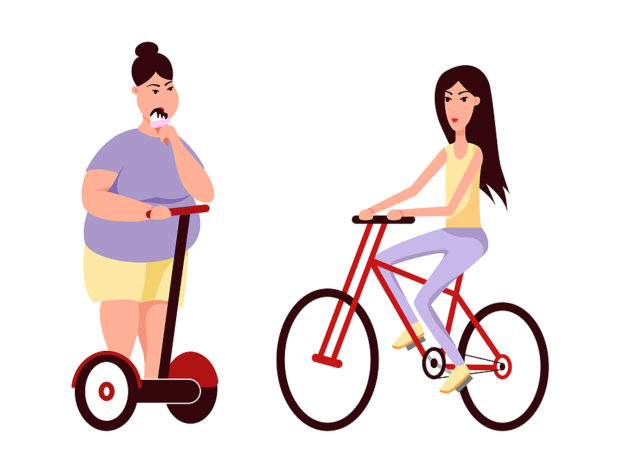By David Blyweiss, M.D., Advanced Natural Wellness
December 7, 2020
I love spending time with my grandson. He’s only 6-years-old, but we have a lot of fun hanging out.
While we’re together, I also do my best to help him learn good habits…
After a recent week of visiting, he knows to climb out of bed each morning and do some light stretching. He even knows to try a few push-ups to strengthen his body before he starts his day…and walking the dog every morning with mom or dad is a given. I just did the circuit with him, my daughter and their golden doodle …1.03 miles in 22 minutes.
During our time together, I learned some lessons too…
For instance, we spent one afternoon watching a Disney movie called Wall-E. Perhaps you’ve seen it.
In this futuristic cartoon, Earth’s entire human population lives on a luxurious generational space ship with a lone cleaning robot named Wall-E left on the planet’s surface.
The humans in this movie are… well… L A Z Y! Really lazy.
Sure, they have all the perks of an advanced technological society and robots who do all the work.
MD Exposes the Hidden Danger to Your Eyes

When your eyesight starts to fail, it's a real problem. Suddenly you can't go to the grocery store... you can't get to the doctor if you have an emergency... you can't meet your friends for dinner…
Your "regular" doctor doesn't have time to keep up with the latest research. And the same goes for eye doctors. They go to school to learn how to fit you for glasses and contacts, but have no way of preventing the damage and loss of eyesight that threatens your freedom and independence.
Let me show you something that explains a LOT about how your eyes work.
In my FREE Special Report, I'll show you a HUGE, untapped resource for your eyes that safely and naturally restores clear, effortless eyesight.
Click here to get started...
But they spend their days lounging around on motorized hover recliners sipping drinks and eating. Just picture those mechanized wheelchair scooters you see at Walmart and you’ll get the idea.
So, what about these people? Are they healthy and happy?
Well, not so much. They are extremely overweight and can’t move around easily because their bodies are so weak from long term disuse.
Does This Scare You Too?
If art is a reflection of society, then this should scare you quite a bit. That’s because people today are spending more time sitting around than is really healthy.
When people stop moving around and instead spend hours at a time sitting still, they are asking for trouble.
Their bodies slowly start to decline — losing muscle and bone mass. Before they know it, their bodies are weak and prone to injury or disease.
Researchers who studied more than 100 adults aged 65-84 found that sitting for long stretches of the day results in a lower percentage of lean body mass.[1]
Remember, if you don’t use it, you lose it!
A life without exercise (which I now just call “movement”) is no life at all. I even tell people that “sitting is the new smoking!” And almost 300 academic articles will agree with me on this exact comparison. [2]
We’re seeing that 9% of ALL premature deaths worldwide can be traced back to inactivity. [3]
After hundreds of thousands of years living a hunter-gathering lifestyle[4], we now spend our time watching Netflix or sitting in front of a computer.
All of this inactivity is having an impact on your health. Let’s just start at the top of the body and look at the brain. We know that the more you walk or exercise, the bigger your brain will become.
The World's Quickest Solution for Ending Prostate and Urinary Misery
This has recently been revealed to be one of the only real breakthroughs in prostate health.
The seeds of a strange fruit (sometimes called "Chinese Apples") hold powerful phytonutrients that are a revolution in prostate health.
In fact, UCLA and Veterans Administration research have now proved this to be true.
Not only that, but it may be the worlds quickest solution for ending prostate misery.
Simply stated, these phytonutrients represent a huge step beyond beta sitosterol, saw palmetto, and other phytosterols alone.
Simply click HERE if you want to have fast prostate relief...restful, uninterrupted sleep...no more constant "urges to go"...enhanced virility...and optimal prostate support for life.
People who exercised three or more times a week had a 30 to 40 percent lower risk for developing dementia than those who exercised less. [5]
Plus, more daily movement means more energy for your body. If you’re just sitting around, you’re not making more of your body’s mitochondria – those little cellular power houses that give you energy. This will lead to an ongoing loss of muscle strength.. if you can’t get up from a chair using just your leg and thigh muscles and not your arms you’re not doing ok.
Daily sitting time or low levels of exercise has a direct relationship with mortality, cardiovascular disease, type 2 diabetes, metabolic syndrome, and obesity too.[6]
4 Simple Ways to Get Moving Again
So, what’s the moral of this little Disney cartoon life lesson?
You need to keep your body MOVING. It doesn’t matter quite so much how you chose to move each day. The most important thing is that you do it.
If my 6-year-old grandson can stick to a daily habit of movement, then I’m sure you can too. Here are a few easy ways to get started:
- Add in daily walking.
This is an easy one. Simply pick a direction and walk in a straight line for roughly ten minutes. Then, turn around and walk back home.
I love listening to my favorite upbeat music while I go for my daily walk. You can walk in a park, through your neighborhood, or even just on a treadmill. It all works fine. If you want a little extra challenge, try a special style called Nordic Walking.
- Try a HIIT working.
This stands for “high intensity interval training.” It’s basically a way to do short bursts of high intensity exercise with rest periods in between.
For instance, you might do a series of 30-second sprints followed by 2-4 minutes of easy walking. I like this style of exercise because it’s all relative. For you, a sprint might just be a faster form of walking. Do what you can within your body’s own limits.
- Work on your balance.
As I’ve gotten older, I’ve begun to exercise my balance more and more. I do this by standing next to a countertop and lifting one leg at the knee. I balance on one leg for as long as I can using the counter as a safeguard in case I need to reset.
- Give light strength training a try.
Strength training includes both weight training and resistance training. Don’t worry if you don’t understand the difference between the two. They both simply describe exercises that use resistance to build muscles.
I’ve had multiple wrist breaks throughout an active childhood and later adulthood, but I can still do some very light weight training to keep my arms strong. Wall pushups, abdominal crunches and planks are also great ways to use your own body weight to strengthen muscles.
I started doing the wall pushups a few years ago. Really, anybody can do wall pushups. You can push yourself farther away as you get stronger. And then, when you’re really good, you can just go on the ground and do some real pushups.
Remember, these steps may seem simple, but each time you get up and move your body, you’re doing something worthwhile. You could be saving yourself from an unhealthy future… where even robots can’t save you!
Sources:
[1] Reid, Natasha, et al. “Association of sitting time and breaks in sitting with muscle mass, strength, function, and inflammation in community-dwelling older adults.” Osteoporosis International 29.6 (2018): 1341-1350.
[2] Chau JY, Reyes-Marcelino G, Burnett AC, Bauman AE, Freeman B. Hyping health effects: a news analysis of the “new smoking” and the role of sitting. Br J Sports Med. 2018;bjsports-2018-099432
[3] Lee IM, Shiroma EJ, Lobelo F, et al.(2012) Effect of physical inactivity on major non-communicable diseases worldwide: an analysis of burden of disease and life expectancy. Lancet 380(9838):219–229.
[4] Baddeley, Benjamin, Sangeetha Sornalingam, and Max Cooper. “Sitting is the new smoking: where do we stand?.” British Journal of General Practice 66.646 (2016): 258-258.
[5] Larson, Eric B., et al. “Exercise is associated with reduced risk for incident dementia among persons 65 years of age and older.” Annals of internal medicine 144.2 (2006): 73-81.
[6] Hamilton, Marc T., Deborah G. Hamilton, and Theodore W. Zderic. “Role of low energy expenditure and sitting in obesity, metabolic syndrome, type 2 diabetes, and cardiovascular disease.” Diabetes 56.11 (2007): 2655-2667.







